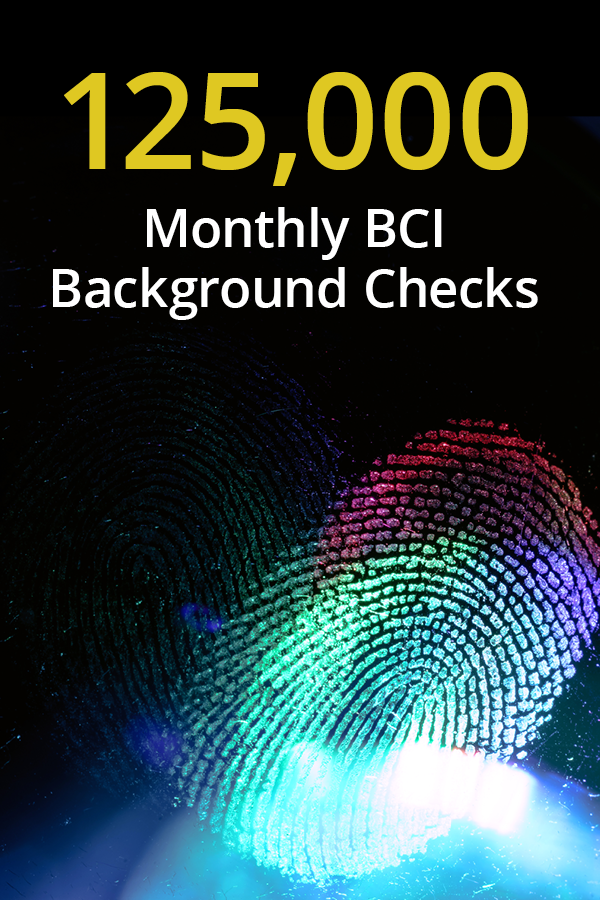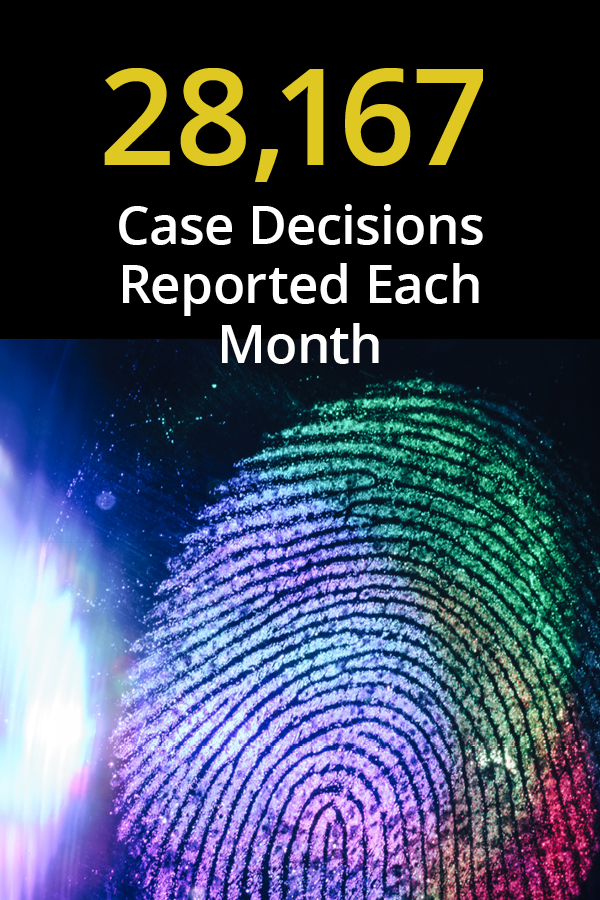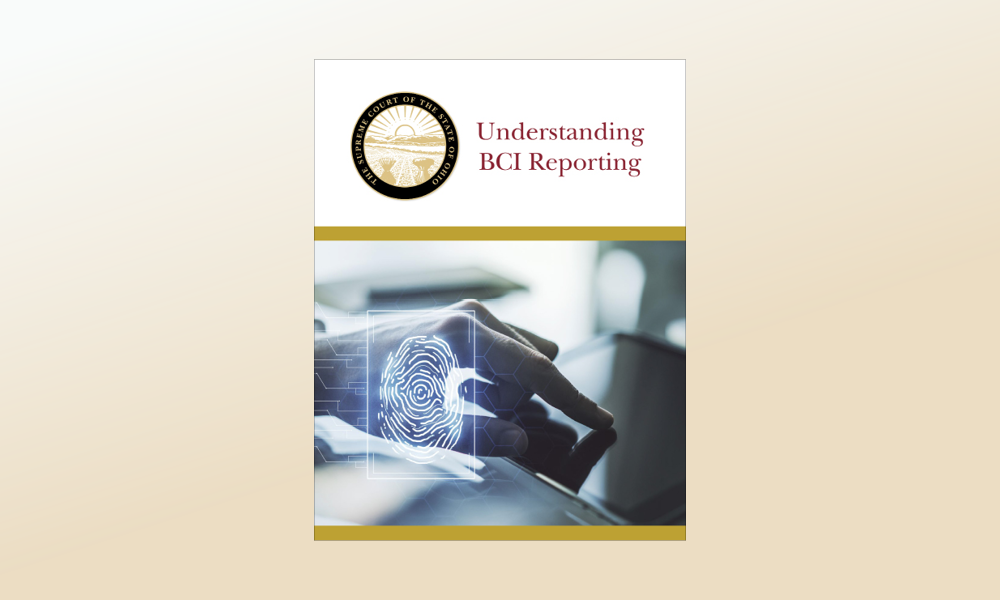Strengthening Public Safety
Background checks with complete information are crucial for protecting the public. The most reliable criminal records database depends on a successful collaboration among Ohio law enforcement, clerks of courts, courts, and BCI.

Branden Meyer was riding a bus when he found an unexpected solution to a work problem. He was with a group of Ohio law enforcement officials, judges, clerks of court, and others who work in the judicial system. They were headed to an FBI facility to learn more about the importance of good data flowing into Ohio’s criminal history database, that then transfers over to the federal agency. As the Fairfield County clerk of court, Meyer knows that the fingerprints of defendants are key to the database, which supplies the information for background checks in Ohio. He was wondering what the clerk’s office could do to better capture those fingerprints and how to pay for a fingerprinting machine.
He tossed his dilemma to the person sitting next to him on the bus. She worked at the Ohio crime lab, the Bureau of Criminal Investigation (BCI). She mentioned that there were federal grants for purchasing fingerprint scanners. When Meyer got back to Fairfield County, he applied.
The tip paid off. The clerk’s office was awarded a $10,000 grant from the U.S. Justice Department through the Ohio Attorney General’s Office – substantially offsetting the nearly $16,000 scanner cost. There was some additional state funding, and the clerk’s office and the Fairfield County Sheriff’s Office each chipped in to cover the rest.
The scanner was stationed inside the Fairfield County Common Pleas Court, offering a convenient way to secure the fingerprints of a defendant who hasn’t yet been printed by the time a criminal case begins in court. Fingerprints are central to accurate and thorough background checks. Two other essential elements are a unique BCI tracking number and the outcome of the related court case when it’s completed. The tracking number is assigned to fingerprints and connects the fingerprints in the BCI database with the record of the decision in the defendant’s case.
Together those three pieces – the tracking number, fingerprints, and case outcome – deliver reliable background checks, which help to keep the public safe. Background checks determine who can buy a firearm. They also are used by employers, to approve the hiring of bus drivers, daycare providers, EMTs, and nursing and assisted living facility staff. They help protect the very young, the elderly, and others in the care of doctors, teachers, pharmacists, and many licensed professionals. In addition, background checks can decide whether someone can adopt a child or volunteer at a school or as a Scout leader.
Arrests and Court Decisions Sent to BCI for Background Checks
BCI is the home base for background checks in Ohio. It’s the repository for the records searched when someone, such as an employer, licensing board, or landlord, asks for a background check.
BCI’s focus is ensuring the quality and completeness of the records that are received and placed into the state criminal history database. Those records pour in from law enforcement, clerks of courts, and courts. Each day, law enforcement agencies in the state send roughly 1,000 arrest records. An average of 1,300 submissions also arrive daily from courts reporting case outcomes, which are called dispositions or, in juvenile cases, adjudications.
Accurate criminal histories depend on coordination across law enforcement, courts, clerks of courts, and BCI. Court records are a vital part of the complete information needed to ensure accurate and timely results for the 1.5 million background checks run by BCI each year. Courts are required to contribute at three important points – by checking on fingerprinting at the beginning of a court case and again at sentencing, and by reporting the outcome of each case to BCI.
“Courts need to have a process in place for comprehensive BCI reporting protocol and to ensure that their system is effective,” Chief Justice Sharon L. Kennedy said. “By providing timely and accurate information to BCI, courts will be doing their best to keep Ohioans safe.”
People Summoned to Court, Like Those Arrested, Must Be Fingerprinted
In many criminal cases, a suspect is arrested by law enforcement, which must fingerprint the person at the time of arrest. Juveniles also must be fingerprinted if taken into custody for a suspected felony or violent offense. When fingerprints are taken, a unique number – called the “ITN,” or incident tracking number – is assigned and attaches to them. Law enforcement is required to send the fingerprints with the ITN to BCI.
Frequently, however, there is no arrest in a case, and people instead receive a summons to appear in court. That means there are no fingerprints at BCI from law enforcement for the pending case. When there isn’t an arrest, and no fingerprints have yet been taken, the roles of the courts and the clerks of courts become pivotal for the background check system.
One court duty kicks in at the arraignment or first appearance in a case. Under state law, the judge must ask whether the defendant has been fingerprinted. If there are no fingerprints on file, the court must order the person to report to the sheriff or local law enforcement agency within 24 hours for fingerprinting.
It’s that order to the defendant where gaps can emerge. Some defendants don’t report to a law enforcement agency for fingerprinting. This problem has led courts and clerks to step in to assist with securing the needed fingerprints for a case. (For courts without their own fingerprinting machines, funding is available.)
Fingerprinting Made Condition of Bond for Defendants in Fairfield County
Magistrate Joshua Horacek at the Fairfield County Common Pleas Court noted that 75% of people indicted in the county are summoned to court rather than having a warrant issued for their arrest.
A defendant who receives a summons must go to the Fairfield County clerk’s office by the appearance date listed on the summons, said Meyer, the clerk of court. There, the defendant needs to sign a bond and report to a bond monitoring officer in the Probation Department. The court leverages this moment to capture fingerprints.
Once at the clerk’s office to sign the bond, the defendant is sent to the deputy sheriffs who work in security at the courthouse entrance, said Michelle Carper, chief deputy in the clerk’s office. A deputy will walk the defendant to the nearby digital fingerprinting terminal and take the fingerprints. Those are submitted electronically to BCI, and the deputy hand-delivers a printout of the fingerprint documentation to the clerk’s office. That hard-copy fingerprint card includes the unique and essential number, the ITN.
In the clerk’s office, a clerk retrieves the physical file for the case. The clerk notes on the computerized docket for the defendant’s case that the fingerprints have been received, Carper explained. The notation alerts the court that fingerprints have been secured. The clerk also scans the fingerprint card and attaches the scan electronically to the case docket. The image allows the details to be made available to appropriate court staff, when necessary.
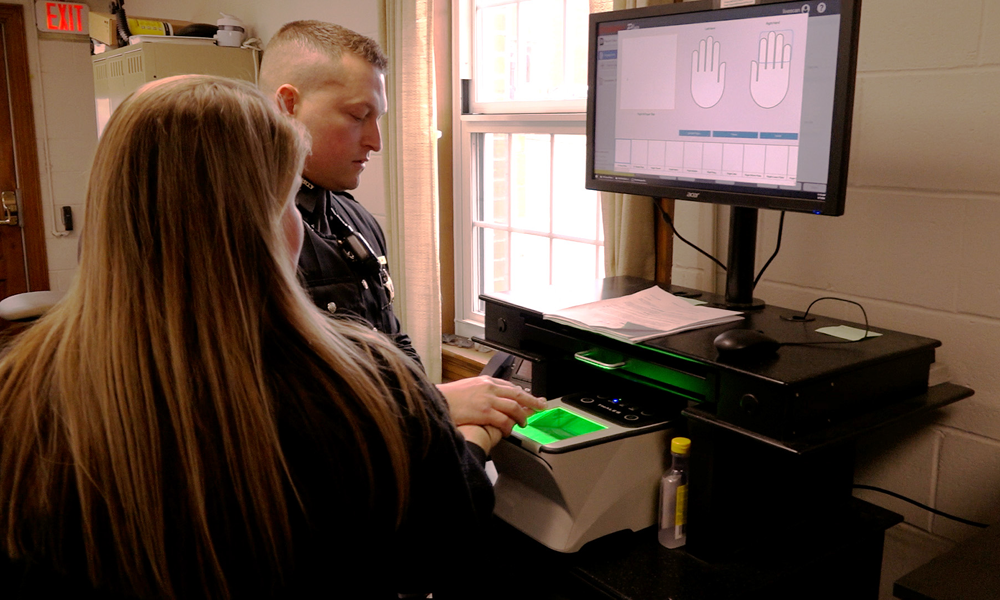
At the Fairfield County Common Pleas Court, defendants who are summoned to appear in a criminal case are fingerprinted while at the courthouse.
The clerk then places the hard-copy fingerprint card into the physical case file. Carper said the outside of the case file is stamped with the letters “FP” so anyone can easily see that fingerprints have been taken. It’s a simple, low-tech solution for staff inside the courthouse to track the fingerprint status.
At the end of any pre-trial hearing where the defendant is present, the judge will check whether the defendant is complying with the terms of the bond – which includes the fingerprint requirement. The judge can easily look at the file to see whether the fingerprinting has been done. If not, the judge will order fingerprints to be taken immediately before the defendant leaves the building.
“An effective background check system must flag action taken by the court, and therefore court involvement is necessary to ensure the effectiveness of any background check system,” said Fairfield County Common Pleas Judge David Trimmer. “The proper use of the court’s authority in compelling fingerprinting when required is a key part of that process.”
Carper explained that the clerk’s office follows the same procedure regardless of whether law enforcement supplies the fingerprints or the fingerprints are captured at the courthouse – a notation on the case docket, placement of the card in the file, and an “FP” stamp on the file. Everyone in the different departments worked together to develop a successful process.
“We have great communication with the court, probation, and the sheriff’s office,” Meyer said.
Defendants Summoned to Court Fingerprinted at Delaware County Arraignments
In Delaware County Common Pleas Court, a person who receives a summons will need to visit the courthouse, said Kristin Schultz, court administrator. Since there are no fingerprints yet because the person was summoned, the arraignment entry includes a condition that the defendant must be fingerprinted, Schultz explained. The defendant is told by the judge or magistrate to immediately report for fingerprinting at the Office of Adult Court Services, which is conveniently located inside the courthouse. That’s where the digital fingerprinting terminal, installed in 2022, is located. A deputy sheriff often takes the defendant to the terminal, ensuring the fingerprints are obtained.
Just as in Fairfield County, the fingerprints are submitted electronically from the terminal to BCI, and a printout of the fingerprint documentation is hand-carried by the deputy to the clerk’s office. Jennifer Tubaugh, chief deputy clerk for the Delaware County Clerk of Courts, noted that the county sheriff’s office also files an “acknowledgment form” with the clerk stating that a deputy fingerprinted the defendant.
“When the clerk’s office receives a fingerprint card, I fasten it in the case file on the lefthand side so the judge can see that the defendant has been fingerprinted by the sheriff,” Tubaugh said.
She added that the acknowledgement form is also put in the case file and recorded on the docket for the case. That notation informs anyone looking at the docket that the fingerprints were received by the clerk’s office.
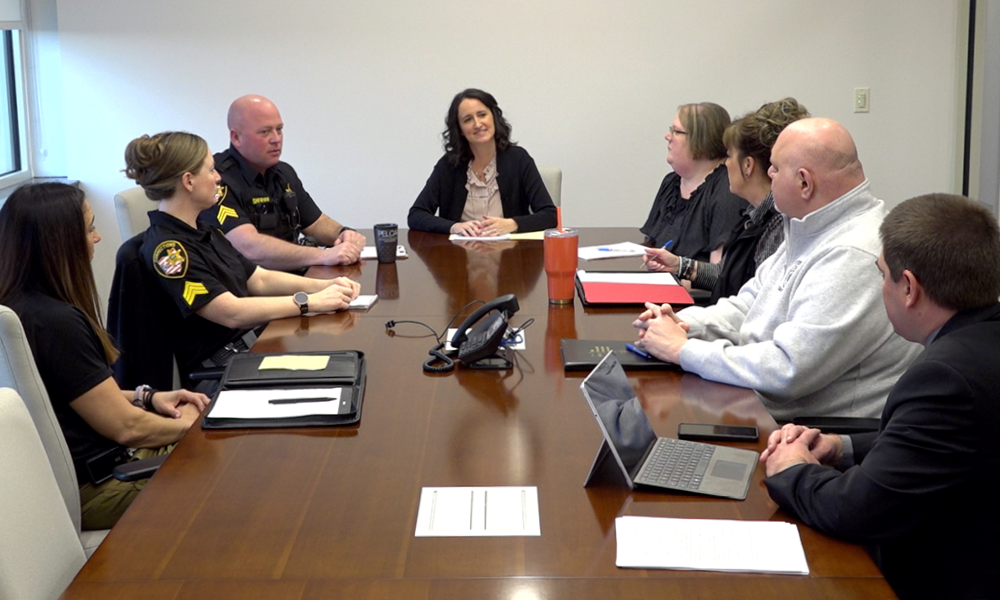
Clerks in Delaware County met regularly with law enforcement and others to build and tweak their process for obtaining defendant fingerprints.
“We have a very smooth process with receiving the fingerprint cards on a daily basis, along with the court ordering the defendants to be fingerprinted after the initial arraignment hearing, so we rarely have a case for which we have no fingerprint card,” Tubaugh said.
Delaware County Common Pleas Judge David Gormley said the process is a priority for the court.
“All of us involved at any stage of the fingerprinting process at this court understand the importance of accuracy in Ohio’s criminal records,” he said.
Delaware County’s effectiveness hinges on teamwork among the clerks, sheriff deputies, jail staff, public defenders, and prosecutors, Schultz said. The group meets every other month to discuss issues that have arisen in the flow of information through their offices. Fingerprinting was a topic at meetings, giving many in the group an opportunity to problem solve.
“We met and detailed the process, documented it, and tweaked as we implemented it,” Schultz explained. “Even our adult probation department will ask a defendant at intake whether they got their fingerprinting done and, if not, they will coordinate with the deputies to take care of it. We really have a lot of stakeholders working together and invested to make sure the fingerprinting occurs.”
Courts Essential for Fingerprint Checks at Sentencing and Reporting Case Decisions
The second point where courts play a significant role in an effective background check system is during a defendant’s sentencing. In cases involving crimes where state law requires fingerprints, judges are mandated by law to check at the time of sentencing or when ruling in a juvenile’s case whether fingerprints have been secured. Just like at the beginning of court cases, if there are no fingerprints on file, the court must order the defendant to be fingerprinted within 24 hours. The court can take the fingerprints or send the person to the sheriff or local law enforcement agency for fingerprinting.
Courts are instrumental to accurate criminal histories in a third way. Courts must report to BCI the outcome of criminal cases where fingerprints were required. Whether a case is dismissed, whether a person is convicted or acquitted, and what offense a person is convicted of will give different results in a background check.
The BCI criminal history database is reported to hold more than 8 million records. The agency enhanced its ability to analyze the records after a 2022 upgrade to the database. In January 2024, BCI found that 45% of the records lacked the report from the court on the case disposition.
For more than a decade, BCI has been converting and entering tens of thousands of paper criminal records, most from 1974 forward, into the criminal history database. Some BCI database records that lack case dispositions could be very old, and others reflect cases still working their way through the justice system. But having case dispositions from courts in the criminal history database is critically important.
To submit a disposition to BCI, the clerk must include the unique ITN associated with the fingerprints in the case. BCI explained that ITNs are often an item that’s missing from courts when they report dispositions. Without that number, it’s much harder for BCI to connect the court disposition to the correct person and criminal history – which can lead to inaccurate criminal background checks.
Variety of Strategies Adopted to Report Case Outcomes
Case dispositions are required by law to be sent to BCI every week. To ensure that the information is submitted to BCI, local courts have found systems that work well for them.
When a person is sentenced in the Delaware County Common Pleas Court, a clerk pulls the fingerprint card from the case file and puts it in a basket.
“That lets me know that the case is finished and prompts me to submit the disposition electronically to BCI,” Tubaugh said.
She enters all the information from the fingerprint card, which includes the ITN, and the sentencing details into the court’s case management system. If it happens that there isn’t a fingerprint card with the ITN in the case file and the defendant was arrested, Tubaugh contacts the sheriff for the information to enter it into the system. Now, she’s ready to transmit the information about the disposition in the case to BCI. The clerk’s office began submitting the records electronically in 2017, after an update to the court’s case management system.
The Fairfield County clerk’s office submits the weekly case dispositions to BCI by certified mail. Carper, the chief deputy, said when a case is closed, a clerk takes the court entry – which is the written documentation of the outcome of the case – and staples it to a “final disposition” form created by BCI. Those materials are mailed to BCI for each case, and the mailing date is noted on the docket.
Carper said that installing the fingerprinting machine and linking fingerprinting to the bond process has “greatly improved the successful transmission of data to BCI.” The court’s list of missing dispositions from BCI has gone from four pages to less than one. Meyer added that they’re continuing to enhance and streamline their process.
“Now that our recent case management conversion is completed, we hope to soon be changing our manual submission method via certified mail to electronic submission,” he noted.
Errors and Omissions Addressed When They Occur
With all these details to track and enter, mistakes can happen. A few safeguards can get those resolved quickly. In Delaware County, the court’s case management system recognizes many errors, including missing data, before anything is transmitted to BCI, Tubaugh said. One omission the case management system can catch is when the name of the arresting agency is missing, she noted.
But if something is incorrect or missing when sent to BCI, or a case disposition is sent without the ITN, the court receives an error report from BCI. She said the most typical mistakes are a citation to the wrong Revised Code statute or a missing arrest date. When an error report is received, a clerk goes in and makes the necessary changes to resubmit, she noted.
BCI is working to improve its error reports. Courts have been receiving them for two to three years now, but BCI acknowledges the reports are quite technical. The plan is to eliminate obscure codes and switch to plainer language that’s more understandable to assist courts.
The efforts in Fairfield and Delaware counties illustrate how Ohio courts are finding solutions to assist with capturing fingerprints and to ensure the reporting of case dispositions. Whether it is through simple stamps on case files or online submissions of case decisions, many across the judicial branch are showing a commitment to report all the correct information to BCI for the best possible background checks statewide.
“Errors or omissions can harm persons who have been charged with or convicted of crimes, and any gaps in that information could also adversely affect potential employers, firearms dealers, law-enforcement officers, crime victims, and the community at large,” said Judge Gormley. “Getting this process to work as it should makes the justice system more fair and protects public safety.”
CREDITS:


